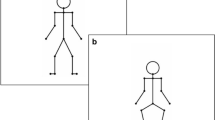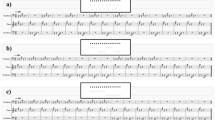Abstract
The “Deutsch’s illusion” occurs in most people when a dichotic pair of tones spaced an octave apart is presented repeatedly in alternation, so that when the right ear receives the high tone, the left ear receives the low tone, and vice versa. The illusory percept consists typically in a single low tone heard at one ear alternating with a single high tone heard at the other ear. Here, we investigate whether the frequency interval between the tones and their duration play a role in the perception of the illusion. By testing 74 subjects we demonstrate that the illusion is not confined to tones spaced an octave apart but it is perceivable also with tones separated by a major seventh, a minor ninth, a major ninth, and a minor tenth. Regarding duration, the present results show that the illusion is stronger with tones lasting 500 than 200 ms. The present results suggest that the perceptual mechanisms at the basis of the illusion are not strictly linked to the frequency relationships between the dichotic tones.


Similar content being viewed by others
References
Bregman, A. S., & Steiger, H. (1980). Auditory streaming and vertical localization: Interdependence of “what” and “where” decisions in audition. Perception & Psychophysics, 28(6), 539–546.
Brennan, D., & Stevens, C. (2002). Specialist musical training and the octave illusion: Analytical listening and veridical perception by pipe organists. Acta Psychologica, 109(3), 301–314.
Chambers, C. D., Mattingley, J. B., & Moss, S. A. (2002). The octave illusion revisited: Suppression or fusion between ears? Journal of Experimental Psychology. Human Perception and Performance, 28(6), 1288–1302.
Chambers, C. D., Mattingley, J. B., & Moss, S. A. (2004). Reconsidering evidence for the suppression model of the octave illusion. Psychonomic Bulletin & Review, 11(4), 642–666. Discussion 667–680.
Chambers, C. D., Mattingley, J. B., & Moss, S. A. (2005). Does selective attention influence the octave illusion? Perception, 34(2), 217–229.
Craig, J. D. (1979). The effect of musical training and cerebral asymmetries on perception of an auditory illusion. Cortex, 15, 671–677.
Deutsch, D. (1974a). An auditory illusion. The Journal of the Acoustic Society of America, 55, S18–S19.
Deutsch, D. (1974b). An auditory illusion. Nature (London), 251, 307–309.
Deutsch, D. (1975). Musical illusions. Scientific American, 233(4), 92–104.
Deutsch, D. (1978). Lateralization by frequency for repeating sequences of dichotic 400- and 800-Hz tones. The Journal of the Acoustic Society of America, 63, 184–186.
Deutsch, D. (1981). The octave illusion and auditory perceptual integration. In Tobias, J. V., & Schubert, E. D. (Eds.), Hearing research and theory (Vol. 1, pp. 99–142). New York: Academic Press.
Deutsch, D. (1983). The octave illusion in relation to handedness and familial handedness background. Neuropsychologia, 21, 289–293.
Deutsch, D. (1988). Lateralization and sequential relationships in the octave illusion. The Journal of the Acoustic Society of America, 83, 365–368.
Deutsch, D. (2004). The octave illusion revsited again. Journal of Experimental Psychology. Human Perception and Performance, 30, 355–364.
Deutsch, D., & Roll, P. L. (1976). Separate "what" and "where" decision mechanisms in processing a dichotic tonal sequence. Journal of Experimental Psychology. Human Perception and Performance, 2(1), 23–29.
Lamminmäki, S., & Hari, R. (2000). Auditory cortex activation associated with octave illusion. Neuroreport, 11(7), 1469–1472.
McClurkin, R. H., & Hall, J. W. (1981). Pitch and timbre in a two-tone dichotic auditory illusion. The Journal of the Acoustic Society of America, 69, 592–594.
Oldfield, R. C. (1971). The assessment and analysis of handedness: The Edinburgh inventory. Neuropsychologia, 9, 97–114.
Ross, J., Tervaniemi, M., & Näätänen, R. (1996). Neural mechanisms of the octave illusion: Electrophysiological evidence for central origin. Neuroreport, 8(1), 303–306.
Vercoe, B. L. (1992). A manual for the audio processing system and supporting programs with tutorials. Cambridge: Massachusetts Institute of Technology Media Labs.
Zwicker, T. (1984). Experimente zur dichotischen Oktav-Tauschung (Experiments on the dichotic octave illusion). Acustica, 55, 128–136.
Acknowledgments
This research is part of the project EDCBNL (Evolution and Development of Cognitive, Behavioral and Neural Lateralization, 2006/2009), supported by the Commission of the European Communities within the framework of the specific research and technological development programme “Integrating and strengthening the European Research Area” (initiative “What it means to be human”), through a financial grant to L.T.
Author information
Authors and Affiliations
Corresponding author
Rights and permissions
About this article
Cite this article
Brancucci, A., Padulo, C. & Tommasi, L. “Octave illusion” or “Deutsch’s illusion”?. Psychological Research 73, 303–307 (2009). https://doi.org/10.1007/s00426-008-0153-7
Received:
Accepted:
Published:
Issue Date:
DOI: https://doi.org/10.1007/s00426-008-0153-7




